Cathy Neal — August 1, 2014
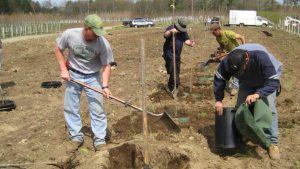
Recent nursery production research conducted in the Northeast has far-reaching implications for the way trees and shrubs are grown, including plant health and quality, environmental impact and return on investment. In Part II of our presentation, we review the economics.
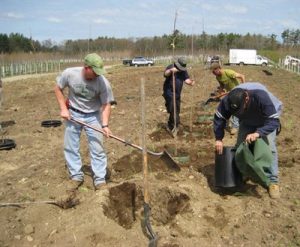
Click image to enlarge.
Labor costs vary across production systems-and at varying stages within each system. Cost to plant differs from maintenance, which differs from harvest, depending upon the number of laborers required and the kind of tools or machinery employed.
Photos courtesy of Daniel Lass
In the July 2014 issue of American Nurseryman, we reviewed growth and root morphology results from our USDA National Institute of Food and Agriculture funded project that compared three tree production systems (see “Getting to the Roots: Product Effects on Tree Root Growth and Morphology,” page 10). Our research project considered how different production systems affected growth and quality of river birch (Betula nigra), swamp white oak (Quercus bicolor) and crabapple (Malus × ‘Prairifire’). In this article, we report on the estimates we developed of costs and returns for one of our species, river birch, that were developed from data gathered at planting and through two growing seasons at our research site in Amherst, Massachusetts.
Our goals were to estimate the average cost per tree for the three different production systems and to measure how those costs vary. Variations in costs represent risk and uncertainty that producers face – costs could be much greater (or lower) than you might anticipate. We’ll discuss some of the differences that we observed; we were most interested in variations in planting costs and harvest costs.
Costs of producing river birch
Different production systems will have different costs per tree because of differences in planting costs, annual costs to maintain the trees (fertilizing, irrigation, general nursery maintenance) and harvest costs. Table 1 reviews the costs of production for river birch trees in Massachusetts for the three production methods we studied. Let’s start with a discussion of the planting costs.
Prior to planting, the nursery prepared the site using a tractor and power rake. The same tractor was then used to auger holes for all the trees. (Our July article gives you more detail on designing the experiment.) Machinery costs to prepare the site (we used daily rental rates for the tractor, power rake and auger) were $1.46 per tree. Adding labor—the tractor operator at $37.50 per hour—brought the site prep cost to $1.85 per tree. All the trees were then planted by two nursery employees working together. Field grown trees were simply placed in the holes, back-filled and tamped. That process took less than 30 seconds per tree, on average, and added just an additional $0.58 per tree. The IGFC (in-ground fabric container) trees required more than three times the additional labor to plant. It was necessary to place the clumps of birch in the fabric containers, center them and then fill the containers. While a sleeve aided the process of filling the containers, the time required was about 93 seconds per tree, which added $1.71 on average. For the PiP (pot-in-pot) trees, socket pots were “planted” in the augured holes. The PiP trees were planted at a trailer set up in the field with bags of soil mix, which took two workers about 2.5 minutes per tree, on average. The potted trees were then carried to the socket pots. The process added $3.34 per tree on average to the planting costs of the PiP system.
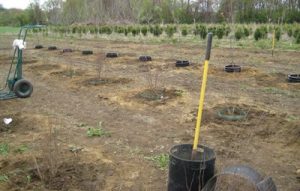
Click image to enlarge.
Trees grown in pot-in-pot and fabric containers, as well as field-grown (B&B) specimens, were evaluated at the Amherst location.
For our research, we wanted the site prep to be the same across all three production systems. While the use of an auger to drill holes is efficient for planting IGFC and PiP trees, the B&B (balled-and-burlapped, field-grown trees) could be planted more efficiently using a planter. We likely overestimated planting costs for the B&B trees. Machinery and labor costs of mechanical planting probably match the site prep costs we have included, so we may be overestimating the B&B costs by around $0.60 per tree.
An irrigation system was installed for the trees. B&B and IGFC trees had the same drip irrigation system (same two emitters for each tree); the PiP trees used two spray stakes per tree. The installed irrigation costs (including labor) were $3.61 for the B&B and IGFC trees, and $3.27 for the PiP trees. Total planting costs include the price of the trees, containers, fertilizer, herbicides and labor. The field-grown trees had the lowest planting costs at $16.93 per tree. These are compared to IGFC costs of $20.95 and PiP costs of $35.29 per tree. The PiP trees required two pots (including the socket pot) and were planted in a nursery mix rather than field soil, which added $6.36 per tree to the costs.
To round out the first year costs, we added additional labor costs (weed control, irrigation, pruning, etc.), land costs, management costs (at 10 percent of expenses) and opportunity costs on the investment (3.5 percent of the first year costs). These are listed as “all other Year 1 costs” in Table 1. These additional first year costs were similar across the three production systems, although the PiP trees required more irrigation and management. Most of the differences in the total Year 1 costs for the three production systems were due to differences in planting costs including the materials needed and the time required to plant the trees.
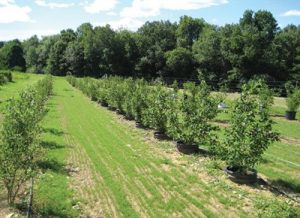
Click image to enlarge.
River birch-the focus of the economic study reported here-are shown in fabric containers and pot-in-pot production at the University of New Hampshire site.
All trees were harvested after two full growing seasons during the fall of 2011. Table 1 shows Year 2 costs separated into the harvest costs, which varied across the production systems, and “all other Year 2 costs,” which included nursery maintenance, management and opportunity costs. These were similar for the three systems with two exceptions: We included a cost for top soil loss for the B&B and IGFC trees at $10 per ton, and the PiP trees required additional maintenance and irrigation costs.
The harvest costs for the B&B and container grown trees differed substantially. The B&B trees were harvested with a tree spade, which added significant machinery costs. The costs of wire baskets, burlap, twine and the labor to process the root balls is also included. Machinery costs were estimated to be $6.45 per tree; labor for operating the machinery and processing the root ball added $6.78 per tree. It took about 2 minutes and 20 seconds, on average, to dig the birch trees, and another 4 minutes and 15 seconds for the B&B operation. By comparison, two men with shovels averaged 54 seconds to harvest IGFC trees; we estimated harvest costs at $2.54 per tree.
The PiP trees were simply lifted from the socket pots, typically in just seconds. Properly placed fabric squares worked well to ensure easy harvest, but we did encounter two trees with roots that escaped past poorly placed fabric squares and into the field soil. These were dug as we did the IGFC trees and the socket pot was cut away, adding additional time and cost to the PiP average. Additional costs to move the trees from the field to a central location were also included. Those costs were lower for IGFC and B&B trees, because we were able to move twice as many container trees as B&B trees in each load.
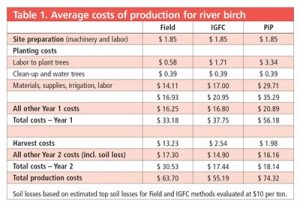
Click image to enlarge.
Our estimates of the total costs of production are at the bottom of Table 1. These are the costs from planting in April 2010 through final harvest in November 2011. While river birch would not be harvested as B&B trees in the fall, what we did to the trees following harvest (air spade and cut the roots from the tree!) made the fall dig problem of no concern. However, a nursery would likely add some additional maintenance costs, or at least opportunity costs, through the winter months for the trees.
The B&B trees had a cost advantage of more than $4.50 per tree over the IGFC trees at the end of the first year and a $23 advantage over the PiP trees. But harvest costs for the B&B trees pushed the final costs of production past the IGFC trees by $8.51 per tree, and reduced the cost advantage over the PiP trees to $10.62 per tree.
Risk and uncertainty—variations in production costs and prices
Our estimates give the IGFC trees a cost advantage over both the B&B and PiP trees, and the B&B trees a cost advantage over the PiP trees. But we are also interested in how costs for each system might vary. In other words, what are the chances that a grower would find that the costs per tree are much greater than the average costs we presented here? First, let’s sort out why costs would vary.
Planting costs were different for each system, but the costs of planting trees within each system also vary. For example, the birch clumps arrived banded together, but some came apart and needed to be reassembled – this added extra time. Some required additional root pruning before planting, and some were just plain stubborn about fitting nicely into the fabric containers or pots. The time required to properly plant trees in the fabric and plastic containers also varied depending on the hole and soil. We recorded the times required to plant trees for each system. (Dan stood around watching and timing other people work!) These data on labor and equipment times were used to determine the means and variations in planting costs for the three systems.
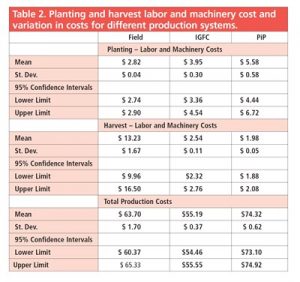
Click image to enlarge.
Table 2 reviews the mean planting costs, standard deviations, and 95 percent confidence intervals for mean planting costs. Planting the field grown (B&B) trees was the fastest—the trees were quickly placed in the ground, backfilled and tamped. The rapid planting also led to a very small standard deviation: On average, planting costs varied from the mean of $2.82 by only about 4 cents. We don’t know what the average costs would be for another grower planting by the same method, but we are 95 percent confident that our interval of $2.74 to $2.90 will cover that unknown mean cost.
The IGFC trees required more careful placement into the fabric container, the container itself had to be properly placed in the hole, and then the bag was filled with field soil. The times required to complete these tasks varied for the trees planted in fabric containers and plastic pots; thus, we found that planting costs varied. The PiP trees were planted using a bagged soil mix at a station near the planting site, then carried to the prepared holes where the socket pots had been “planted.” IGFC planting costs varied from the mean of $3.95 by about 30 cents, on average. Again, while uncertain about the average costs per tree for another grower following the same process, we are 95 percent confident that our interval of $3.36 to $4.54 will include that mean cost. PiP planting costs varied by about 58 cents on average around the mean of $5.58, and our 95 percent interval prediction for average planting costs per tree is $4.44 to $6.72.
Mean harvest costs and the variation in those costs are also shown in Table 2. The cost of harvesting field grown trees as B&B trees varied around the average of $13.23 by $1.67, on average. Harvest costs for the B&B method include the costs of a skid-steer loader and tree spade, the operator, as well as a team of two men who completed the B&B process wrapping the root ball in burlap, a wire basket and cord. Positioning and pulling the tree from the ground occasionally was difficult, requiring additional machinery time. Some root balls needed “trimming” before wrapping, adding to the variation in costs. While we are uncertain about the average harvest costs, we’re 95 percent confident the average cost would be covered by our interval, $9.96 to $16.50.
IGFC tree costs varied from the mean of $2.54 by 11 cents, on average. The IGFC trees were harvested by two men with two shovels, which required less than one minute on average, including time to knock extra soil off the fabric container. With little variation in the costs per tree, our 95 percent interval estimate of the average cost per tree is also quite narrow, ranging from $2.32 to $2.76.
There was even less variation around the average cost of harvesting the PiP trees. With a few exceptions, the PiP trees were simply lifted from the socket pots. We did find a few difficult PiP trees whose roots had escaped past the fabric squares designed to keep all roots within the pots. Under those conditions, the socket pot was harvested and cut from the pot containing the tree. Those trees are what added to the costs and variation in costs. On average, costs per tree varied by just 5 cents around the average cost of $1.98. Our 95 percent confidence interval for the mean cost per tree ranged from $1.88 to $2.08. The variation relative to the mean for the B&B harvest costs was 12.6 percent, compared to just 4.3 percent for the IGFC costs and 2.5 percent for the PiP trees. These ratios indicate the relative cost uncertainty across production systems.
The last set of values in Table 2 shows our estimates of the total average costs per tree for the three different systems. With the information about how planting and harvest costs vary, we can give interval estimates as well for the different systems following our procedures. We are 95 percent confident that the average costs of production for field grown trees, planted and harvested as we did, would be covered by our interval $60.37 to $65.33. For the IGFC trees, the range is from $54.46 to $55.55 and for the PiP trees from $73.10 to $74.92.
Conclusions
We found that the field grown (B&B) trees had a real advantage in costs per tree in the first year. Those costs included getting the trees planted and maintaining them through the first growing season. We estimate that growers would realize a savings of about $4.50 per tree over the IGFC system and $23 per tree when compared to the PiP trees.
While the PiP system offers substantial harvest cost savings, we did not find that they could overcome the greater planting costs for those trees. Assuming that the trees planted can be sold at harvest and the average prices were the same across the three systems, our findings from the field trials conducted in Massachusetts during the 2010 and 2011 growing seasons would suggest that the IGFC production system for growing river birch would earn greater net income per tree. And, that production system has less risk in costs than both the B&B and PiP systems.
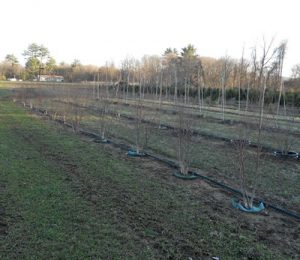
Click image to enlarge.
Irrigation lines provide supplemental moisture for trees grown and evaluated at the study’s Amherst location.
The primary difference in costs that favor the IGFC method are the harvest costs. While the B&B method had lower planting costs, the machinery requirements and the processing requirements of the B&B method add substantial harvest costs and risk when compared to the IGFC trees. IGFC trees were harvested by two men with two shovels in an average time of 54 seconds. Contrast this to an average harvest time of 2 minutes 21 seconds for B&B trees using a tractor with a tree spade.
There are a number of features of IGFC that enhance its attractiveness as a landscape tree and large shrub production system. However, in our trials relatively few trees (about 30 during a morning) were harvested by the men with shovels, and their speed would certainly diminish throughout a long day harvesting many trees.
One noteworthy limitation to the findings of this study pertains to any errors that might occur when overplanting due to overestimation of the demand. If more trees are planted than can be sold at harvest, remaining trees can simply be left in the ground for harvest at a later time when using the B&B production system. If the IGFC system is used, the size of the knit fabric container chosen at planting may limit the ability to postpone harvest when demand does not materialize as anticipated by the time of harvest. This issue may suggest that larger knit fabric containers be employed at planting to add flexibility of harvest date into the IGFC production system for at least a portion of the crop to insure against times when expected demand is not realized.
The IGFC and PiP systems do appear appealing to small-scale producers considering an alternative that reduces production costs and soil losses. In addition, we have not considered the reduction in transportation costs for those producers that deliver a number of trees to landscapers or retail centers. We also do not consider the desirability of the different trees to consumers, ease of handling versus the possible attraction of a large rootball that may provide a better start for the tree.
Daniel Lass is Professor and Chair of the Department of Resource Economics at the University of Massachusetts, Amherst. He can be reached at [email protected]. Cathy Neal, Ph.D., is Extension Professor in the Department of Biological Sciences, and nursery and landscape horticulture specialist for University of New Hampshire Cooperative Extension She can be reached at [email protected].